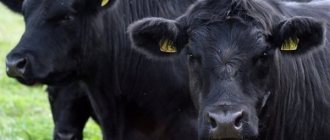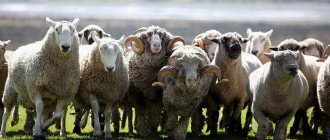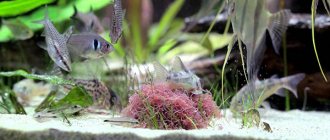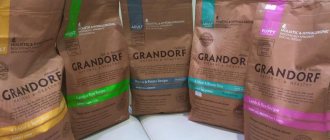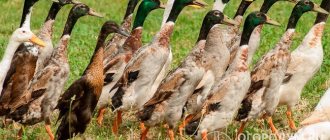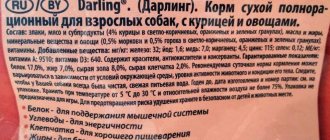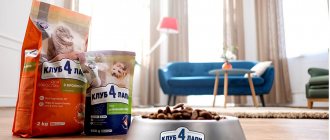1 954
no comments yet
0
Author:
Rasskazov Pavel.
Reading time: 2 minutes
Young poultry obtained from crossing meat-combined lines for growing for meat and characterized by rapid weight gain are called broilers.
Typically, such crosses are 20-30% larger than purebred birds. At the age of 60 days, young broilers can be sent to slaughter: their weight during this period reaches 1.5-2 kg.
Broiler meat is considered a dietary product. It is non-greasy, soft, tender. Can be used to feed children, the elderly, during illness and recovery periods.
What are the advantages and features of colored broilers
Unlike other crosses, colored broilers are characterized not only by high meat productivity, but also by good egg production. You can get from 180 to 300 eggs per year from one hen. The meat productivity of such crosses is 4-6 kg.
Colored broilers are characterized by the following external characteristics:
- wide powerful back;
- elongated muscular torso;
- large chest;
- thickened strong paws;
- colorful plumage.
Colored broiler chickens are characterized by rapid growth. The average daily weight gain of young animals is 60 grams.
Problems during selection, disadvantages of individuals
Broilers cannot be too small; already 1 month after hatching, the chickens look like 2-3 month old chickens. If this is not the case, then an unscrupulous seller has been caught who passed off a bird of a different breed as a colored broiler.
Sometimes birds begin to limp or stop growing. In this case, the breeders are not to blame. Attention should be paid to the nutrition and maintenance of individuals.
Low quality feed, spoiled or not containing the required amount of vitamins, provokes lameness. Lack of light and crowding lead to stunted growth.
Incubation
To obtain young colored crosses of appropriate productivity, hatching eggs are purchased from breeding farms. The peculiarity of the incubation of such eggs is the duration of ventilation . They need to be cooled for 30 minutes 2 times a day, unlike the eggs of other laying hens, which require two 10-minute airings.
Chick development by day. Signs of correct and incorrect development of the embryo
Read
How to choose the right eggs to put in the incubator?
Answer
Brooders for chickens in different price segments. For hobbyists, farmers and industry
Top – 9
Review of industrial and amateur incubators for breeding chickens
Top – 15
Conditions for successfully raising broilers at home
In order to preserve the chicks and raise them into healthy and strong broilers, the young animals need to be properly cared for and fed rationally.
Broiler care
- To keep chickens, a warm, dry and bright poultry house is required. The temperature in it should not fall below +2C and rise above +27C. In the first days, chickens need a temperature of at least +25C, then it can be gradually reduced.
- Birds are raised both in cages and on the floor. In the second case, no more than ten chickens can be placed on one square meter of floor.
- You should use hay or sawdust as bedding. Change the litter frequently to keep it dry. If the poultry house is clean and dry, then the possibility of infections will be minimal.
- Poultry house illumination is required to be average. Only the feeders should remain brightly lit.
If illnesses cannot be avoided, try to find out the cause of the illnesses and eliminate it. Coughing can occur if the temperature in the coop is too low and the humidity is too high. It is necessary to insulate the room, make ventilation, eliminate drafts and install a heater.
Often the cause of the disease is poor nutrition: poor food, deficiency of protein, vitamins or microelements. The diet of birds must be balanced, complete and appropriate to the age of the chickens.
Insects that parasitize birds are the main spreaders of infections. It is necessary to regularly carry out insecticidal treatment of the poultry house.
Chickens need a first aid kit with the necessary medications: antibiotics, first aid, vitamin preparations. It is important to use them correctly to prevent epidemics and death of birds.
What to feed chickens
Ready-made feed mixtures are used to feed broilers. They have a balanced composition, containing the necessary microelements and vitamins. If ready-made food is not available, you can make the mixture yourself. It includes:
- shit from corn, oats, wheat, barley;
- sunflower cake;
- yeast;
- meat and bone meal;
- low-fat cottage cheese.
The ingredients are diluted with curdled milk.
The birds are fed with wet mash of grated carrots, cabbage and other vegetables, dandelion leaves, nettles, and green onions.
Limestone, crushed shells, egg shells and chalk are added to the food. They contain calcium necessary for growth. Birds constantly need clean water.
Nutrition
The diet of colored crosses should be balanced, enriched with minerals and vitamins. The menu required for broilers includes grains, vegetables, fruits, herbs, and animal proteins. Chickens are fed 4-5 times a day with wet mash.
- Stern
- Recipes
- Supplements
Compound feed pk-1
Description of food for egg breeds. Instructions for feeding laying hens
Read
Compound feed pk-2 and pk-3
Mineral and vitamin compositions, feeding standards
Read
Compound feed pk-4
Used to feed laying hens aged 15-17 weeks
Read
Compound feed pk-5
Composition and instructions for feeding broiler chickens
Read
Purina® Pro
Important differences from the previous line, application patterns Start, Growth, Finish
Read
Barley and wheat for laying hens
Germination and steaming of barley and wheat for chickens: how to do it correctly and how to give it to laying hens
Read
Wheat for broilers
Rules for feeding broiler chickens with wheat. Dosage for chickens from the second day of life and adult birds
Read
Mash
Making mash for broilers at home
Read
Rice and buckwheat
How and in what form you can use rice and buckwheat to feed chickens. Standards for adult birds and chickens
Read
Bread
What kind of bread can you feed chickens and how to do it correctly
Read
Fish
The product is given in limited quantities: overfeeding can cause serious harm to the bird
Read
Chalk
Chalk as a food additive for chicken feed. Feeding standards for chickens, young animals and laying hens
Read
Meat and bone meal
Meat and bone meal is a mandatory additive for feeding chickens, containing protein and fats of animal origin.
Read
Fish fat
How to give fish oil to chickens, layers and broilers. What are the benefits of the drug and are there any contraindications?
Read
Limestone
Limestone (dolomite) flour in the diet of chickens. Advantage over chalk and feed shell
Read
Salt
Daily dosage of salt for adult birds and young animals and cases of unwanted use
Read
FAQ
When to slaughter colored broilers
Growing cauliflower in open ground
Most often, experienced farmers recommend slaughtering colored broiler chickens at the age of 80 days. However, such a rule is not mandatory. For profitability purposes, some entrepreneurs advise slaughtering when the weight of the bird increases to 2.5 kg.
Why broilers don't stand up
As a rule, at the age of 3 weeks, many colored broilers begin to have problems with their legs: they move little and stay in place more. The problem most likely lies in poor-quality food or non-compliance with the rules of rational feeding for birds of this species. Until day 21, the broiler’s muscle mass develops especially intensively. The skeleton itself does not keep up with development, and therefore cannot withstand such a load. The problem can be prevented if the bird's weight is measured in a timely manner. Light mode technology should be used if a chicken at the age of 14-16 days weighs 100 grams more than its norm.
Broilers fall to their feet
Why do broilers grow poorly?
Although the broiler chicken variety is characterized by rapid weight gain, sometimes owners complain that the birds grow very slowly. There may be several reasons:
- The owner did not provide optimal temperature conditions for his “wards”.
- Poor quality nutrition, which causes protein deficiency in the birds’ bodies. As a result, broilers are thin, but long.
- The territory is too large for the breed, so the chickens walk a lot and lose weight.
With a little care and effort, every owner in just a few months can fill their refrigerator with high-quality white poultry meat, eggs, and even receive a whole brood of chickens to raise next year.
0 0 votes
Article rating
Diseases
Colored broilers have strong immunity. The main health problems encountered in these birds are lameness and slow growth.
- Parasites
- Infectious
- Other
Chicken mite
How to treat a chicken coop and how to treat a bird. Description of drugs and methods of control
Read
Coccidiosis
Thirst, loss of appetite, swelling, bloody droppings, anemia, weakness, poor coordination
Read
Ascariasis
Loss of appetite, liquid droppings, pale mucous membranes of the comb, limbs, ruffled plumage, lethargy, vomiting
Read
Amidostomiasis
Symptoms of the acute form: apathy, general weakness, decreased or lack of appetite, breathing problems, unsteady gait, retarded growth and development
Read
Prostagonymosis
Decreased mobility, loss of appetite, unsteady gait, bloating, fever, impaired egg laying, exhaustion
Read
Knemidocoptic mange (“lime foot”)
Acute symptoms: light gray bumps appear on the legs, the bird limps and stands on one leg, the cloaca and joints become inflamed, the beak is deformed
Read
Heteracidosis
Symptoms: indigestion, diarrhea, loss of appetite, lethargy, decreased egg production, retarded growth and development
Read
Trichomoniasis
Symptoms of the acute form: fever, depression and loss of appetite, diarrhea with gas bubbles and a putrid odor, enlarged goiter, difficulty breathing and swallowing
Read
Pullorosis (typhoid fever, salmonellosis)
Weakness, lack of coordination, drooping eyelids, difficulty breathing, lack of appetite, indigestion
Read
Colibacillosis
Lack of appetite, thirst, sudden increase in temperature, pale scallops, diarrhea
Read
Pasteurellosis
Fever, foamy mucus, change in stool color, refusal to feed, thirst, lethargy, wheezing, heavy breathing
Read
Marek's disease
Paralysis of the limbs, difficulty breathing, severe exhaustion and loss of strength, refusal of food and water, pallor of the scallop
Read
Gumboro disease
Diarrhea, loss of appetite, trembling legs and head, sudden death
Read
Laryngotracheitis
Weakness, swelling of the neck, difficulty breathing, cough, wheezing, blood clots in the mucus released when coughing, lack of appetite, indigestion
Read
Bird flu
Refusal to eat, anorexia, diarrhea, purulent discharge, hoarse breathing, greenish-brown droppings, seizures, darkening of the ridge
Read
Newcastle disease
Decreased appetite, fever, respiratory distress, immobility, conjunctivitis, bloody diarrhea
Read
Apteriosis
Complete or partial absence of plumage, loss of tail feathers, broken embryonic fuzz in young animals, delayed growth of plumage, pecking
Read
Pterophagy
Plucking and eating feathers. What is the reason, why does it require urgent intervention and how to prevent the disease?
Read
Yolk peritonitis
Symptoms of the acute form: loss of appetite, gray-green color of feces, sudden drop in egg production, calcareous deposits on the shell, bluish tint and baldness of the abdominal skin
Read
Cloacite
Symptoms: depressed state, decreased appetite, weight loss, increased need for water, loss of plumage, inflammation and bulging of the cloaca, the presence of ulcers on the mucous membrane, decreased egg production
Read
Naked breed of chickens: description
The bare-necked breed of chickens, as mentioned earlier, is more reminiscent of turkeys than chickens. The key point in describing the representatives of the breed is the absence of feathers on the bird’s crop and neck. This feature is characterized by the fact that on these parts of the bird’s body the feather follicles are undeveloped. A so-called feather cap is formed on the back of the bird’s head, and in front of the neck the feathers are arranged so that they resemble a bow.
Bare-necked chickens also lack plumage under the wings; these areas are called apteria. When a bird has a lot of such hairless areas on its body, this means that it corresponds to the description of the standard of its breed. There are also no feathers on the small triangles on the inside of the lower leg.
The nakedness of these birds is formed in the embryonic period, when the feather papillae begin to develop. This trait then passes on to adults.
The bare red neck is the result of the work of breeders. It goes very nicely with a bright red “cap” on the head of hens or a voluminous bright crest of roosters. If we are talking about a bare-necked hen, then she has beautiful earrings of the same bright color.
As for other points describing the appearance of these birds, they are as follows:
- the beak of bare-necked chickens is slightly curved and has a scarlet or yellow color;
- eyes have a red-orange tint;
- Birds molt every year, during which time they completely change the outer layer of their skin;
- the head is small but wide, the crest is rose-shaped or leaf-shaped;
- growth is small;
- the body has the shape of a rectangle, the body is elongated and slightly elevated;
- the chest is rounded, this is achieved due to well-developed pectoral muscles;
- the wings are loosely adjacent to the body, slightly lowered down;
- short and strong legs, they have four toes, they are gray or yellow-orange in color;
- a small and fluffy ponytail is located at an angle of 15 degrees to the body, large and formed braids.
The feather cover of bare-necked chickens can have the following shades:
- cuckoo;
- white with black edges;
- motley;
- black;
- brown;
- red;
- blue with border.
The weight of an adult chicken is about 2-3 kg, but a rooster can weigh four kilograms.
What is not allowed in the appearance of bare-necked chickens:
- when the eyes are very dark;
- on bare areas the skin turns yellow;
- the tail is steep;
- the body is weak;
- earrings are white;
- head black;
- the neck and inner part of the lower leg are feathered.
Pros and cons of a hybrid
Redbrown chickens are popular due to the following advantages:
- Versatility . Redbro is considered one of the best egg-meat breeds.
- Rapid growth and weight gain . This indicator is especially important for those who sell chicken carcasses.
- Unpretentiousness in content . Chickens do not require special care and are not picky eaters.
- High survival rate . The indicators are above average both when eggs are hatched by chickens and when they are kept in an incubator.
- Low temperature resistance . Chickens tolerate walks at -5°C and continue to lay eggs.
- Sustained immunity . With proper care, ribs practically do not get sick.
- Flexible character . Redbros can be kept in the same coop with laying hens of another breed.
- Attractive appearance . Representatives of this breed look quite bright and can become a decoration for any yard.
- Short shedding . In redbros, this process proceeds much faster than in other egg-meat chickens.
The disadvantages include the fact that it is not possible to breed pure livestock at home. Young animals have to be purchased from breeders, and unscrupulous sellers pass off unproductive hybrids as redbreds, since the appearance of chickens of this breed is similar to ordinary laying hens.
Poultry keeping
Redbros are quite unpretentious in their content. But there are some nuances that should be taken into account when arranging a poultry house for chickens of this breed.
Chicken coop and equipment
An unheated but insulated poultry house is suitable for keeping redbros, which should also be quite spacious. The recommended height of the chicken coop is up to 1.8 m. Containers with sand or ash are installed in the poultry house for cleaning feathers.
It is recommended to keep no more than 20 chickens per 10 m2.
If you plan to grow redbros for meat, it is recommended to keep them in cages.
Perches
Redbro perches are installed in a place protected from drafts. It is recommended to place them at a height of 40-50 cm. The optimal length of the crossbar for one chicken is up to 30 cm, the distance between the bars is no more than 40 cm, their thickness is about 7 cm.
Nests
The recommended height of nests for laying hens of the Redbro breed is 30 cm, depth is 35 cm. It is recommended to place them in a remote and fairly shaded part of the house. There should be one nest for every 4 laying hens.
Video 1: arranging nests and perches in the chicken coop
Video2: The most convenient and compact place
Video3: Nests for laying hens
Feeders
It is recommended to place deep and voluminous chicken feeders along the walls of the chicken coop. They should be made of plastic or metal, since wooden containers will quickly get wet from wet mash. Food containers should be scalded with boiling water every day, disposing of uneaten remains.
Drinking bowls
Plastic or enamel drinkers should also be installed in the poultry house. Metal containers are not suitable because they quickly rust when in contact with water. Ceramic drinkers are not safe for redbirds because they can break off and ingest particles, which can be fatal.
Litter
The litter must remain dry. It should be changed every year with the onset of spring and autumn. It is recommended to use wood shavings, peat or straw as flooring material. The optimal thickness of the litter is from 10 to 15 cm.
Temperature and humidity
The optimal temperature for keeping a redbro broiler in the warm season is no more than +27°C. In winter, chickens feel good even when the temperature drops below +7°C. Additional heating is only necessary if the temperature in the poultry house drops below +5°C.
It is important to avoid drafts. To maintain the humidity level within 25-30%, it is recommended to install a window inside the house. It should be covered with a net to prevent insects from entering the coop.
Video1: The cheapest heating in a chicken coop
Video2: Ventilation and heating in the chicken coop
Video 3: Decrease in temperature and egg production
Lighting
The optimal length of daylight for redbro is 13 hours. In order for chickens to continue laying eggs in winter, daylight hours will need to be artificially extended.
Room hygiene conditions
Cleaning the chicken coop should be done once a month, and disinfection of the floor, walls and equipment – 2 times a year. For treatment, it is recommended to use a solution of creolin (5%) or soda (2%). After disinfection, the poultry house is also whitewashed with lime.
Sulfur bombs are effective in the fight against parasites and fungi. But they can be used to treat the poultry house only if there are no chickens.
Additionally, disinfection treatment must be carried out before introducing new redbred stock into the poultry house.
Tips and recommendations from experts on choosing poultry
Experts advise buying redbred chickens only from trusted breeders. It is desirable that the seller has a large livestock.
It is recommended to purchase chickens at one month of age, as they adapt more easily to new living conditions.
When purchasing, you should pay attention to the appearance of the bird. She must have all the breed characteristics. Short limbs, insufficiently bright colors and large wings are a sign that the chickens are not purebred representatives of the Redbred breed.
When choosing eggs for incubation, you should also pay attention to how they look. The shell should be clean and smooth, without roughness or growths.
Character
Work on the variety continues to this day. The company that deals with it continues to improve the birds. We can definitely say that their character is quite calm - the winged flock is not prone to aggression, is peaceful, but often suffers from stress.
Due to excessive timidity, the quality of the masonry may deteriorate. But they are raised mainly for their carcasses, so there are no problems due to timidity.
Breeding
When breeding this breed, it is important to consider the number of females and males. A male can fertilize up to 10 hens
Eggs should be placed in an incubator, since hens do not sit on them for long periods of time. But they take excellent care of their offspring. At first, the chickens should be kept in a warm and dry place, which should be ventilated periodically. Gradually, as you grow older, the temperature decreases. Chickens grow quickly and gain weight; keeping them is also easy.
The chicken diet includes the following products:
- Ground eggs;
- Crushed grains;
- Carrot;
- Beet;
- Greenery.
Wheat bran can also be added to chicken feed; it contains all the necessary elements. After 2 months, you should add corn grains and fish oil to your diet, they will help prevent obesity.
Every second hour, the chicken feeder needs to be replenished with food. Accordingly, they must be kept clean, and uneaten food must be removed. This way you can preserve the health of your chickens.


